
The short answer is koi fish live an average of 30 - 40 years in the wild. With high water quality and care, koi in captivity can live into their 70's.
The oldest living koi named "Hanako" was born in 1751. Hanako died in 1977 at the ripe old age of 226 having many owners throughout the years. You are probably wondering "how do you know how old she was?" being that she lived through generations of people.
According to professor Masayoshi Hiro, the man who examined the scales of Hanako, the age of a koi can determined by counting the rings on the scales when examined under a microscope.
The scales develop rings as the seasons change. A large ring develops during the warm season while a smaller one develops during the colder months when their metabolism slows, making it possible to determine the age of the fish.
Nutrition
Besides having high water quality (link to our article about improving water quality through better filtration) there are other factors that can aide in the longevity of your koi. Having proper nutrition is another part of the puzzle.
Just like you and me, koi need all the essentials. Their diet should consist of 35% -40% protein, 5% - 8% fats, 30% - 40% carbs, and 5% fiber. The color of your koi can also be enhanced by their diet.
Koi have different needs depending on the season when it comes to nutrition. Here are some great choices for nutrition through the season. and is what we use to feed our koi.
TetraPond Koi Vibrance (link to Amazon for the best price) Premium Nutrition with Color Enhancers is what we use to feed our koi through the summer months.
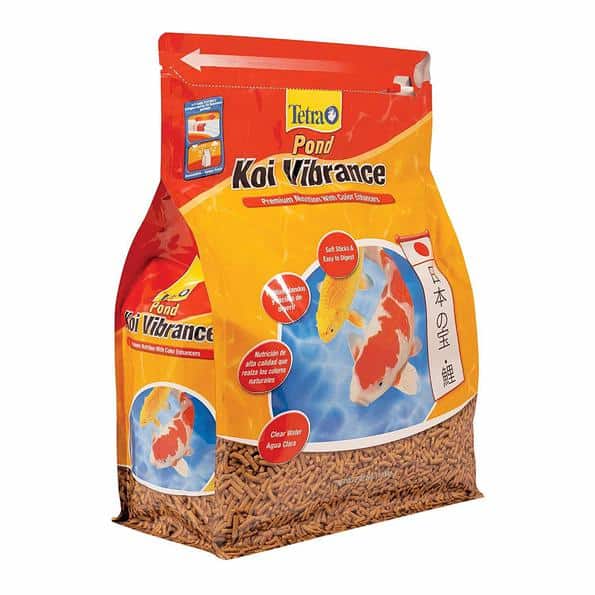
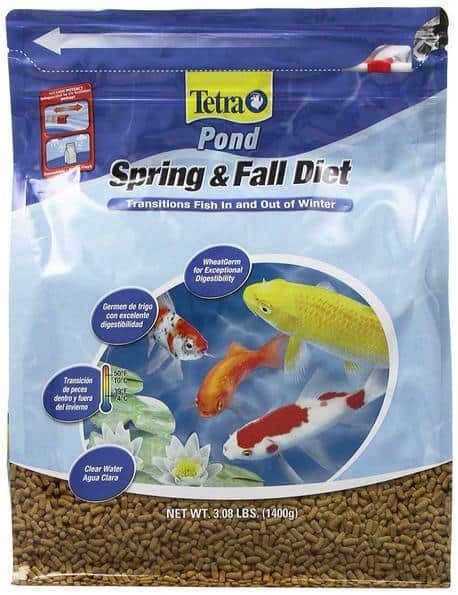
When it comes to fall and spring nutrition we use TetraPond Spring & Fall Diet (link to Amazon for the best price) Floating Pond Sticks Fish Food. We have found this to be the best option for our koi through out the years.
If you want to give your koi a treat, cutting oranges in half and letting them float around until they have been devoured is a wonderful snack. Just be sure to remove the rinds when they are done so they don't clog your filter.
Koi - Basic Facts
- The average lifespan for a koi is between 30 - 40 years.
- The average size of a koi when they are fully grown is around 3.28 feet.
- Koi grow an average of .79 inches (2 cm) per month during the warmer months.
- Koi have no stomach, only a straight digestive track. Whatever they eat they pass through in about 4 hours.
- Koi can weigh up to 35 pounds when full grown.
- Koi spawn when conditions are right, but the small fry and eggs need to be protected.
Determining Males from Females
There are subtle differences that distinguish the males from the females. If you know what to look for you will be able to tell the kings from the queens. In this article you will learn how to tell the difference between male and female koi. What circumstances are needed to entice spawning, and how to breed koi for profit.
Determining males from females is a difficult task when they are young. Koi should be at least 3 years old and out of their juvenile stage to be able to easily tell the difference between males and females.
Once they reach a length of about 12 inches or so they can be identified. The male koi has a more slender body and the pectoral fins (the fins located near the gills) are more pointed than round. This is easier to see when comparing the two rather than looking at one fish, especially to the untrained eye.
Koi have what’s called a vent on their underside located between the anal fin and the anus. This is an opening that excretes either sperm or eggs, depending on the sex.
When it comes to gender identification the vent differs between males and females. A male fish has a more concave vent, while the females will be slightly protruding. When comparing the two, a male vent will be linear, a female will form the shape of a “T”. See the pictures below.
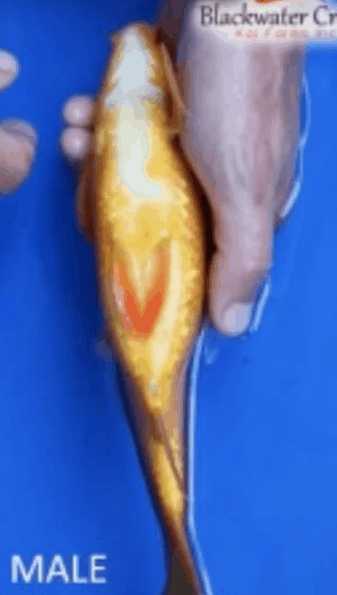
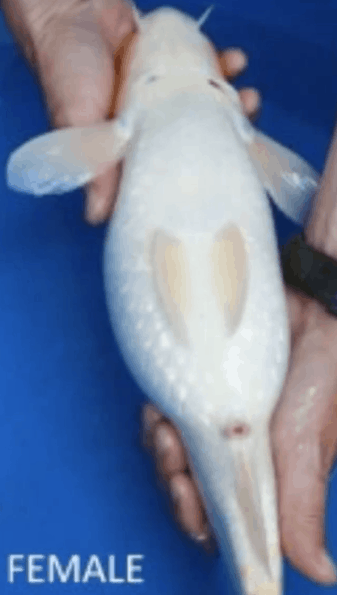
How To Know When My Koi Are Spawning
Koi spawn when the conditions are optimal, and all their basic needs are taken care of. Water temperature and being well fed are two contributing factors.
You may notice a fishy smell in the air. The water in your pond is murky and it looks like someone spilled dish soap into your pond water. These are signs that your koi are spawning.
Don’t go into a panic and try to “fix” your frothy water. This is normal and your pond will return to its natural state once the spawning cycle has finished.
Life Cycle of a Koi From Egg to Maturity
Eggs are fertilized day 0 => eggs hatch by day 4 and attach themselves to something surviving off their yolk sac => koi swim on their own by day 7 => by the age of 1 a koi will reach 3 to 4 inches => considered a juvenile until year 3, at which point it will begin the annual spawning process and its growth will slow down.
Conditions For Koi to Spawn
In order to “make it happen” the koi should be well-fed about a month or so before you wish them to breed. Breeding usually takes place in late spring or early summer, when the water temperature is 60 - 70 degrees F (15.5C - 21.1C)
Koi are able to start breeding by the age of 3. They are in their prime between the ages of 3 and 5, not to say they won’t breed after 5, but this is the most optimal time.
Koi need to feel confident about where they lay their eggs. A fry mat can provide this, or a “sanctuary” can be designed into their habitat.
Get Started Breeding Koi For Profit
There are two ways to get started breeding koi for profit. You can breed only purebred koi for their pedigree, or you can breed koi and raise them, only to sell them when they are full grown. If you have ever looked at a pond shop or pet store, the difference in price between a 3 inch koi and a 14 inch koi are miles apart.
If you choose to go the first route, then you need to understand how to pick out the most desirable characteristics and breeds of koi. This is an acquired skill and will take some practice to master. These characteristics can be broken down into 4 main categories
Breeding For Show
Color - Believe it or not color is not a constant. For instance when the water temperature is warmer the color of the fish may actually fade. Color is affected by many factors, such as diet, water quality, stress, and age.
When it comes to color, the most desirable attributes are a distinct sharpness and deepness. Even on a koi that is a solid color, like white or black. The uniformness of the color is important as well. This is where the next attribute takes over.
Pattern - There should be no blemishes, and scales should be uniform with no “dirty” marks. The pattern can be varied but must be distinct with sharp edges from one color to the next.
Character - yes if you have ever watched koi for any length of time you will notice they all have different personalities. Some will be more dominant and confident while others are shy. This characteristic is strictly judgmental and is not a definitive point of judgment. This is where experience comes into play.
Size - To answer the age old question, yes size does matter. When it comes to judging koi in competition bigger is thought to be better. Once koi reach a certain size it is a sign of maturity. I know the koi in my pond have changed quite a bit as they grew from 3 inches to full maturity. As they have grown, their color and patterns have changed as well.
In addition to the size, symmetry is taken into consideration. The pectoral fins, tail, head and shoulders must all be symmetrical, without any deformities.
Examples of Prize Winning Koi
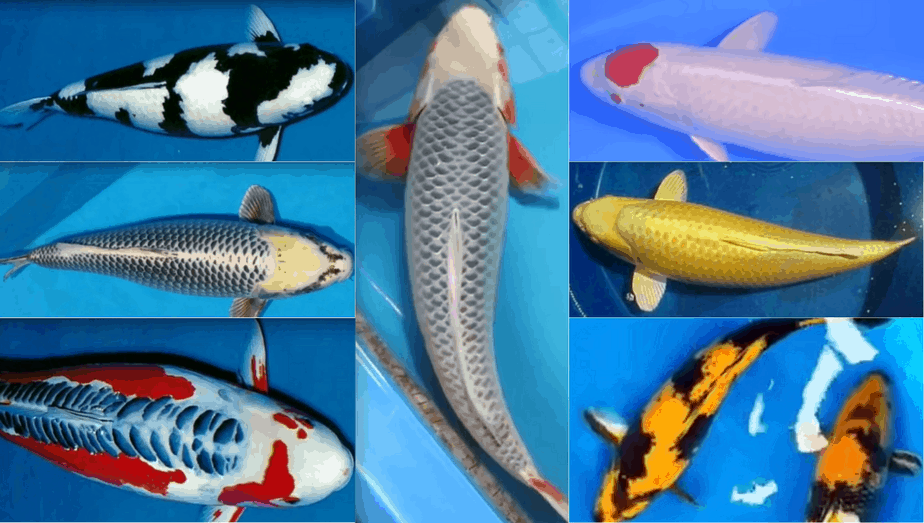
Having all this being said, beauty is in the eye of the beholder. The price tag that goes along with any given fish can only be as high as someone is willing to pay. A healthy fish is all that truly matters.

Besides breeding for show you can choose to raise koi and sell them once they have reached maturity. This can be a very lucrative business, once you have at least a male and a female that have the characteristics you would like to pass onto the next generation.
Although koi lay thousands of eggs, only a handful of them will make it to maturity. With that in mind, a separate pond or holding area needs to be set up with high water quality and a place for the koi to lay her eggs.
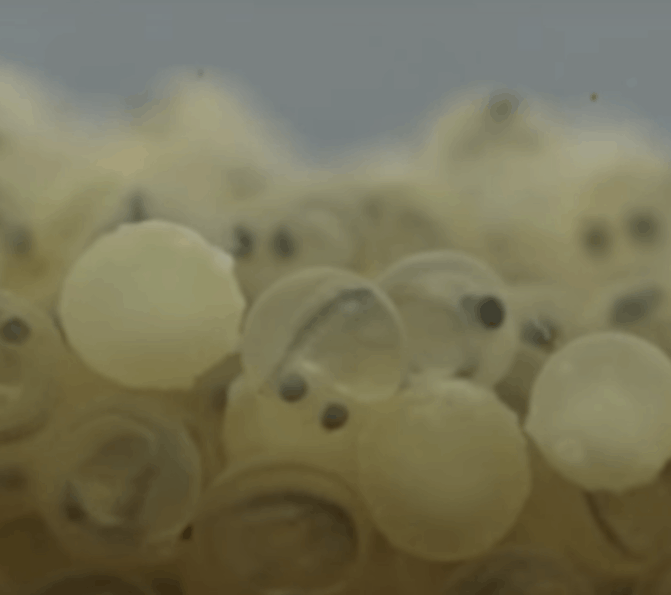
A male and female should be placed in the tank. To help entice breeding the fish should be fed regularly, up to four times per day.
Once breeding has occurred the water will be murky and foamy. There will be a fishy odor in the air. At this point the adult fish need to be removed in order to increase the survival rate of the soon to be small fry.
Successful Breeding Techniques
Tips to increase the success of your breeding process.
Once the small fry hatch they will need protection from predators and their parents.
Keeping water quality high
Koi should be well fed leading up to and during spawning
Use a breeding mat
Remove the adult koi as soon as breeding has occurred.
Conclusion
The hobby of fish keeping, especially when it comes to koi has become a fascination and obsession for me. No matter what your intention, there is no question that koi will bring joy into your life. I know for me it has brought hours of wonder and enjoyment.
What are your experiences with these wonderful creatures? Please comment below. Did you find this post helpful?
Works Cited
Koi Hanako - Longest Living Freshwater Fish Ever. www.fishlaboratory.com/fish/koi-hanako-longest-living-fish-ever.
Lee, Richard (3 August 2013). Essential Guide for Koi Fish Owner: How to Build and Maintain a Beautiful Koi Pond. Lulu Press, Inc. ISBN 978-1-304-28627-7.



The koi fish lifespan depends on the owner care but they really can outlive their owner like the famous hanako koi fish who lives 200 years old